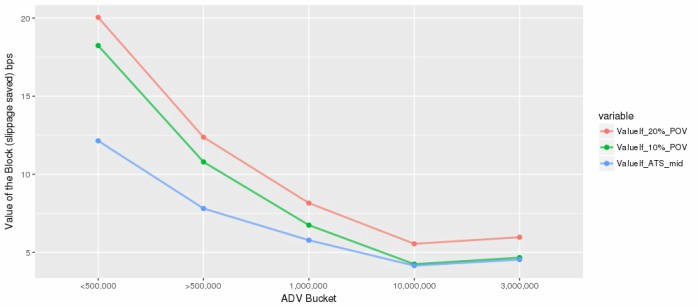The buy-side wants blocks.
The sell-side wants to deliver the buy-side blocks.
So, whats the cost savings of a block execution using an algorithm for a stock?
Well, according to recent research from Cowens Algorthmic Trading Group and shared with Traders Magazine, based on analysis of conditional orders in the firms algorithmic trading strategies the estimated value saved of an average block execution is at least 6 basis points, and can be significantly higher in less liquid securities.
The firm noted that its own algos have been able to capture large blocks using conditional orders, with an average fill size of 29,000 shares. The analysts said that conditional liquidity is extremely valuable for traders looking to execute larger orders, especially in the current fragmented and low-volatility US equity landscape.
Other points the firm noted:
- The average notional value of conditional fills is around $2,000,000.
- The estimated value of the block captured using Cowen algos is at least 6bps, on a ~29,000 share block.

These are the same sorts of orders clients are accessing when they self-direct order flow into venues like BIDS, Liquidnet or BlockCross, the firm reported. However, automated conditional orders have much faster response times than when a trader manually places a conditional order in a block venue, and automated conditionals can be seamlessly integrated into broader algo strategies. This helps to reduce a traders work flow, as the algo manages directing orders and responding to firm ups across multiple destinations.
Cowens liquidity seeking algorithms -SEEK, Block SEEK, and BEST – the subject of this analysis, currently have access to 17 dark venues and 9 conditional venues.
The firm added that since implementing conditional orders into its algos, it noticed that larger fills have begun to make up a significant portion of its overall fills – north of 20% of certain clients notional volume traded, which has improved overall performance.
On average, conditional fill size have ranged from 16,000 shares to over 50,000 shares, depending on the stocks ADV, Cowen shared with Traders Magazine. These numbers are over 100x the average fill sizes at a lit exchange or ATS. The average notional value of a conditional fill has been over $1.5M across all ADV buckets, which is a sizeable value of risk reduction. When taking a stocks ADV into account, conditional fills represent a significantly higher percent of ADV in lesser liquid names.
So what is the value of Block?
Block liquidity captured using conditionals is valuable because it allows for instantaneous risk and timing reduction. To quantify the value of the block we calculated two metrics:
a. Additional slippage, if that block was traded at 20%, 10% of volume or at midpoint in ATSs instead of a single large execution – using a proprietary expected cost model
b. Block size compared to average display size
On average, conditional block liquidity captured by the firms algos saved about 8.8 bps in additional impact cost if that block had been instead traded at 20% POV.
We understand participation rates have been coming down, so we ran the same analysis at 10% POV, and the savings was still 7.4 bps, the analysts said. The savings would be about 6bps if the block size was executed in dark pools / ATSs at the midpoint, however, participation rates would vary based on availability of contra side liquidity – increasing timing risk. The value of each individual block is based on the block size, alternate strategy, stock characteristics, and market conditions. The block liquidity is about 5.5x the display size, saving spread cost and potentially avoiding several aggressive take waves, which can be costly.
What about less liquid stocks?

Many can argue that finding block liquidity in liquid names is easier and should therefore be cheaper but what about less liquid names? Cowen said that larger prints are indeed more valuable in less liquid names.
What was most interesting to us in this analysis was how vital these larger prints can be in less liquid names. When we chart out these numbers, below, we see that for stocks that trade 1 million shares or less per day, block executions are increasingly valuable.



